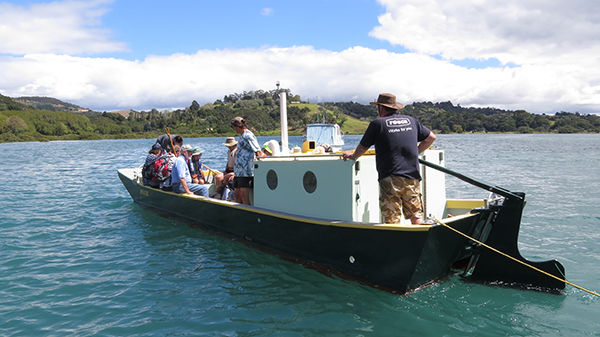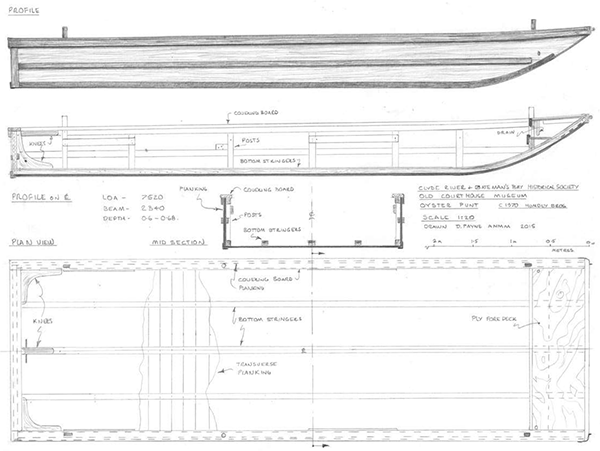Seeing coastal path for the trails, great regional park for the parks
author Cimino
published 25 March 2022
notified 27 March 2022

Sticking to the Path: Eight years after she deck-handed aboard her family’s pioneering oyster barge, Caitlin Owston-Doyle, as a Mahurangi Action committee member—and business owner—helps oversee the organisation’s transition to ferry operator. Pictured here about to depart Wenderholm Jetty is but one of the many groups recruited to advocate for the Mahurangi Coastal Path during the last four decades—nothing worth having comes without some kind of“…you got to kick at the darkness ’til it bleeds daylight.” Lovers in a Dangerous Time, Bruce Cockburn 1984 a fight“…you got to kick at the darkness ’til it bleeds daylight.” Lovers in a Dangerous Time, Bruce Cockburn 1984.
image Sarah Ransom
Waiwera to Mullet Point, is a coastline mostly of regional parkland—all but about 3.5 of the 13 kilometres from Mahurangi Island to Mullet Point already is. Yet, that all-but contiguous 1000 hectares of regional parkland is officially five separate parks—six, unless a major,
joint submission dissuades Auckland Council from dividing Mahurangi Regional Park into two.
There have been consequences to treating the greater-Mahurangi regional parkland in a piecemeal manner, particularly for the Mahurangi Coastal Path. A coastal path is a wonderful thing, even where it connects only two bays. But when it spans coastline as richly attractive as the Mahurangi coastline, and links 1000 contiguous hectares of regional parkland —— no sub-14-syllablesupercaliflawjalisticexpialidoshus, Helen Herman, 1931: …you have said in one word what it would ordinarily take four paragraphs to explain. superlative could come close to satisfying.
Seeing 1000 contiguous hectares of regional parkland as one, great Mahurangi regional park, makes a coastal path along it seem the most natural thing in the world. Some would walk it regularly, others once, but none who walked it would ever forget the day they first did. Within a very short time, and certainly within a generation, nobody will think to ask whose idea the coastal path was. There will be the occasional clue, however, as to who helped to make it happen. One such clue will be the name of the ferry connecting the Mahurangi Coastal Path across the Mahurangi Harbour, the J Barry Ferguson.
Aside from the desirability of seeing the greater-Mahurangi regional park, for the half-dozen individually named, there is a need to see the Mahurangi Coastal Path as a whole, linking the Mahurangi coastline, Waiwera to the Mullet Point. This is about to be made a little easier as a consequence of constructively addressing the confusion caused since the coining of Matakana Coast Trails, with the earlier, 1980s onward, Mahurangi Coastal Trail concept. Despite involving reasonably distinctly different-sounding worlds, the human brain is famous for its ability to patch together a phrase, title, or sentence, from snatches heard. By renaming the 14-kilometre Waiwera to the Mullet Point section Mahurangi Coastal Path, the name of the entity dedicated to its creation becomes the Mahurangithe entity could have gone overboard and further differentiated by adding Board, given that that is what it is, as opposed to a membership-based organisation Coastal Paththe entity could have gone overboard and further differentiated by adding Board, given that that is what it is, as opposed to a membership-based organisation Trustthe entity could have gone overboard and further differentiated by adding Board, given that that is what it is, as opposed to a membership-based organisation—a title, which, even if said quickly, sounds significantly different from Matakana Coast Trails Trust.
So, to the renaming of the 4.9-metre aluminium landing barge that is currently being relieved of its Auckland Regional Parks livery, prior to its purchase by Mahurangi Action Incorporated. A little sealore being a dangerous thing, not to mention superstition itselfit is bad luck to be superstitious!, many imagine that it is improper to change the name of a vessel. On the contrary, it was the usual, respectful practice for the new owners of a craft to rename their new charge—as often as not, to honour a mother, wife or daughter. Another misapprehension is that because vessels are traditionally ascribed the feminine gender, their names must be feminine. Fortunately, this is far from the case, with local examples being the R Tucker Thompson, the William C Daldy, and the Edwin Fox. Meantime, a Mahurangi example, the Helen B HappyWork like…, invoked the local work ethic, rather than a fondly regarded female. Otherwise, for an owner to change a vessel’s name midstream, so to speak, was indeed believed to seriously invite misfortune.
Philanthropy—literally, the love of humanity—has its detractors. Mahurangi Action Incorporated, however, has no such qualms, having seen the satisfaction gained and the value created, such as with the publication of Jade River: A History of the Mahurangi. In that example, two bequeathers and two underwriters were ultimately involved. Further, legacy is more than vanity. In this case, by naming the first Mahurangi Coastal Path ferry the J Barry Ferguson, not only is a philanthropist honoured, curious coastal path walkers will learn about the impact that the Mahurangi made on one Christchurch-boy-made-good-in-New-York, on his retirement back to Aotearoa. And he on it, urging, for example, the stops be pulled further out, on preparations for the Mahurangi Regatta Ball, 2004, celebrating Warkworth’s 150th.

Mahurangi Coastal Path Party: For the first year or three, parties rather than individuals will be ferried across the Pūhoi Estuary. The next stage will involve scheduled services on summer and holiday weekends. By then it should be apparent as to whether the pioneering ferry service should be replaced by a footbridge, the southern abutment of which would likely be a little farther upstream than the land at the extreme right of this image. Here, Mike Owston-Doyle helms the Pooh upstream of the sandbank, before turning to cross the estuary, 2014.
image Sarah Ransom
The first J Barry Ferguson won’t be the last. Bigger and better ferries will be required, probably within a few years of the Mahurangi Coastal Path being trialled. At the Pūhoi Estuary, where the ferry will initially be deployed, a single vessel will only keep up with the demand for so long. And even with a J Barry Ferguson ii and a J Barry Ferguson iii in service, demand for an elegantly serpentine, unobtrusive footbridge at the upstream extentin respect to the southern footbridge abutment of the regional parkland may see the ferries freed up for the Mahurangi Harbour crossing, Ōtarawaoknown more recently as Sullivans Bay by tangata whenua but before that as Jacksons Bay, and, prior to settler influence, as Ōtarawao to Lagoon Bay.
Mahurangi Action, having stepped up to purchase the surplus-to-operations landing barge, is on track to begin trialling the Mahurangi Coastal Path early next summer, Waiwera to Te Muri and even Waiwera to Lagoon Bay. After taking delivery of the landing barge and renaming her the J Barry Ferguson, the first priority will be having a qualified volunteer scope the process and cost of getting the vessel back into survey, and having Mahurangi Action certificated as a marine transport operator. The committee will then decide on whether to pursue that route or begin more modestly. The difficulty with the low-key approach is that use of the vessel would very possibly be strictly restricted to members. The ability to ferry council and funding agency representatives, for example as part of demonstrating the coastal path, could be significantly compromised. Recently received, preliminary professional advice suggests that the by-the-book approach is probably imminently achievable.
With a purpose-built aluminium landing barge at the ready, surely now the greater Mahurangi regional park can be seen, for the individual parks; and the Mahurangi Coastal Path, for the trails.

Less-Rough-Cut Punt: Despite such Australian models, the Sid Punt, in its Brain of PoohIn Which Piglet is Entirely Surrounded by Water, Winnie-the-Pooh, A A Milne, 1926 iteration, was the first Mahurangi oyster craft to be given a nicely curving transition between bow and bottom, à la this Clyde River, Batemans Bay example.
drawing David Payne | Australian National Maritime Museum
Seeing barge for the punts Waiwera Concessions, a family business established to operate the Waiwera Mineral Pools, was an early marine farming leaseholder, in Dyers Creek. Guided by government adviser Les Curtainprince of a man, who spent his last months of his government employment removing the vast area of long-since-surplus-to-operations oyster spat-catching racks from Huawai Bay, himself, manually, lured for life from New South Wales, the first Mahurangi oyster farmers built punts, as opposed to flushed-decked barges. Ex-naval officer Sid Hicks built a particularly rakish one, which would have done the Hawkesbury River proud. Subsequently acquired by Waiwera Concessions, it was particularly valued for its ability to be pushed by two strong men across wet mud, fully loaded with harvested oysters, saving an hour here and there waiting for the tide to otherwise refloat.
When the family’s solitary outboard finally wore out, the Sid Punt became the 9-metre self-draining barge Brain of PoohIn Which Piglet is Entirely Surrounded by Water, Winnie-the-Pooh, A A Milne, 1926. Powered by a pre-war single-cylinder Villiers diesel with a crank handle that felt as though it had done more hours than its engine —— a donated mast and sails often brought the Pooh—as she was known to the next and subsequent generations—home in shorter time.
Disclosure The author of this article is the secretary of both Mahurangi Action Incorporated and the Mahurangi Coastal Path Trust. The article published here, however, is that of the editorially independent, independently funded Mahurangi Magazine.
 1 2 3 fix mmp
About, about…
Annual report
chart competition
Climate-action mobilisation
hmss Buffalo
Jade River: A History of the Mahurangi
Mahurangi Action Inc.
Mahurangi Action Plan
Mahurangi Coastal Path
Mahurangi Gallery
Mahurangi Magazine
Mahurangi Regatta
Open-ground indigenous plants establishment trials
Regional parkland
Watermills, millraces, dams and weirs
1 2 3 fix mmp
About, about…
Annual report
chart competition
Climate-action mobilisation
hmss Buffalo
Jade River: A History of the Mahurangi
Mahurangi Action Inc.
Mahurangi Action Plan
Mahurangi Coastal Path
Mahurangi Gallery
Mahurangi Magazine
Mahurangi Regatta
Open-ground indigenous plants establishment trials
Regional parkland
Watermills, millraces, dams and weirs


